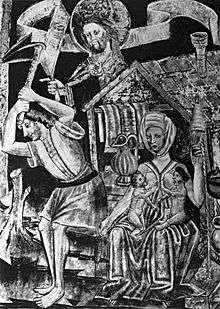John of Kastav

John of Kastav. Detail of the painting of the church in Hrastovlje. 1490
John of Kastav (Latin: Johannes de Castua; Croatian: Ivan iz Kastva; Slovene: Janez iz Kastva) was a 15th-century Istrian artist, a native of Kastav (Croatia).
He painted the frescoes in the Church of the Holy Trinity, Hrastovlje, which included a famous Danse Macabre.[1][2] According to the inscription, which identifies the artist as magister Johannes de Castua, the frescoes were commissioned by Tomić Vrhović, the parish priest of Kubed, and completed in 1490.[3]
References
- ↑ Norm Longley, The Rough Guide to Slovenia (2004), p. 189.
- ↑ Tomislav Vignjević, Ples smrti: prispevki k ikonografiji mrtvaškega plesa v Bermu in v Hrastovljah. Koper: Založba Annales, 2007. With summaries in Italian and English: "La danza della morte: contributi all'iconografia della danza della morte di Vermo e Cristoglie"; "The Dance of Death: contributions to the iconography of the dance of death in Beram and Hrastovlje". ISBN 978-961-6033-91-6 . Reviewed by Barbara Španjol-Pandelo in Ikon, 1 (2008), pp. 295-298.
- ↑ Fučić, Branko (2006). Iz istarske spomeničke baštine [From the Istrian Monumental Heritage] (in Croatian). 1. Matica hrvatska. p. 318. ISBN 9789531507790.
This article is issued from Wikipedia - version of the 2/6/2015. The text is available under the Creative Commons Attribution/Share Alike but additional terms may apply for the media files.